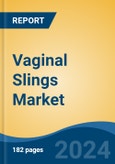Hospitals & Clinics is the fastest growing segment, North America is the largest market globally
Speak directly to the analyst to clarify any post sales queries you may have.
10% Free customizationThis report comes with 10% free customization, enabling you to add data that meets your specific business needs.
Key Market Drivers
The global vaginal slings market is significantly influenced by the escalating prevalence of stress urinary incontinence and other pelvic floor disorders, representing a substantial and growing patient demographic. These conditions, often underreported, necessitate effective treatment solutions. According to "Prevalence, Risk Factors, and Impact on Life of Female Urinary Incontinence: An Epidemiological Survey of 9584 Women in a Region of Southeastern China" published in August 2023, the prevalence of stress urinary incontinence was 12.7% among the surveyed female population.Key Market Challenges
Diminished patient confidence significantly affects market expansion as individuals become more hesitant to undergo procedures with reported adverse outcomes. According to an International Continence Society (ICS) abstract presented in 2024, in a study analyzing 3,307 women who underwent midurethral sling procedures, 21.3% of those requiring revision surgery experienced mesh exposure as an indication for the intervention. Such statistics regarding complications directly contribute to patient apprehension, reducing the willingness to pursue surgical treatment for conditions like stress urinary incontinence.Key Market Trends
A significant trend shaping the Global Vaginal Slings Market is the discernible shift towards minimally invasive single-incision slings. This evolution in surgical technique focuses on reducing patient trauma, operative time, and recovery periods compared to traditional mid-urethral slings. These devices facilitate a less complex surgical approach, potentially leading to increased patient acceptance and broader adoption by medical professionals. According to a review published in *Urogynecology (Phila)* in September 2025, single-incision slings consistently demonstrated high subjective cure rates ranging from 73.3% to 94.2% and objective cure rates from 61.5% to 94%, with operative times generally between 10.7 and 20.4 minutes. Such favorable outcomes contribute to the growing preference for these less invasive solutions.Key Market Players Profiled:
- Boston Scientific Corporation
- Coloplast Corp
- Promedon S.A.
- AMI GmbH
- Johnson & Johnson Services Inc.
- Betatech Medical
- Caldera Medical Inc
- Neomedic International SL
- Cousin Surgery
- Lotus Surgicals Pvt Ltd.
Report Scope:
In this report, the Global Vaginal Slings Market has been segmented into the following categories:By Product:
- Tension-Free Vaginal Tape Slings
- Transobturator Slings
- Mini-Slings
By Type:
- Midurethral Sling
- Traditional Sling
By End-User:
- Hospitals & Clinics
- Ambulatory Surgical Centers
By Region:
- North America
- Europe
- Asia Pacific
- South America
- Middle East & Africa
Competitive Landscape
Company Profiles: Detailed analysis of the major companies present in the Global Vaginal Slings Market.Available Customizations:
With the given market data, the publisher offers customizations according to a company's specific needs. The following customization options are available for the report:- Detailed analysis and profiling of additional market players (up to five).
This product will be delivered within 1-3 business days.
Table of Contents
Companies Mentioned
- Boston Scientific Corporation
- Coloplast Corp
- Promedon S.A.
- AMI GmbH
- Johnson & Johnson Services Inc.
- Betatech Medical
- Caldera Medical Inc
- Neomedic International SL
- Cousin Surgery
- Lotus Surgicals Pvt Ltd.
Table Information
| Report Attribute | Details |
|---|---|
| No. of Pages | 186 |
| Published | November 2025 |
| Forecast Period | 2024 - 2030 |
| Estimated Market Value ( USD | $ 3.02 Billion |
| Forecasted Market Value ( USD | $ 4.02 Billion |
| Compound Annual Growth Rate | 4.8% |
| Regions Covered | Global |
| No. of Companies Mentioned | 10 |









